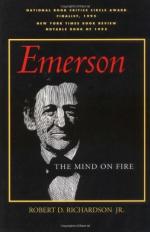
|
| Name: _________________________ | Period: ___________________ |
This test consists of 15 multiple choice questions and 5 short answer questions.
Multiple Choice Questions
1. What was the focus of "The Dial" under Emerson's editorial leadership?
(a) Culture and philosophy.
(b) Science and history.
(c) Art.
(d) Literature.
2. Who is Osman?
(a) Emerson's nephew.
(b) Emerson's aunt.
(c) Emerson's daemon.
(d) Emerson's servant.
3. How does Richardson characterize 1844 in Emerson's life?
(a) A year of transition.
(b) A year of endings.
(c) A year of beginnings.
(d) A year of losses.
4. Whose coffin did Emerson open toward the end of his life?
(a) Waldo's.
(b) Mary Moody Emerson's.
(c) His mother's.
(d) Ellen's.
5. What objection did Emerson make to Charles Fourier's utopian ideas?
(a) He had too much faith in people.
(b) He was too optimistic.
(c) He was too dependent on science.
(d) He was too pessimistic.
6. What was Emerson's frame of mind on returning from Europe?
(a) Filled with doubts about his philosophy.
(b) Disappointed, haunted by possibilities.
(c) Delighted, at the peak of his career.
(d) Unhappy, almost angry.
7. What did Emerson begin to write about after returning to America?
(a) The political events he witnessed.
(b) His trip to England.
(c) Getting older and facing death.
(d) The realizations he had in the Paris Jardin des Plantes.
8. In what realization of Pythagoras' was Emerson interested?
(a) That everything is spirit.
(b) That all things are made of material.
(c) That not everything was in flux.
(d) That change was the only constant.
9. What was Emerson's hobby?
(a) Farming.
(b) Beekeeping.
(c) Building furniture.
(d) Orchard keeping.
10. What did Emerson turn his house into?
(a) A boardinghouse.
(b) A restaurant.
(c) A library.
(d) A hotel.
11. How does Richardson characterize Emerson's fame?
(a) Moderate.
(b) Almost dangerous.
(c) Momentary.
(d) Semi-divine.
12. How does Richardson characterize Emerson's feeling about the essay "The Poet?"
(a) He thought it was one of his best.
(b) He felt more uncertain of that essay than any other.
(c) He was afraid to believe in his own prophecy.
(d) He was afraid of the censure it would draw.
13. How does Richardson characterize Emerson's works after he turned forty?
(a) More relaxed.
(b) More mystical.
(c) Darker.
(d) More confident.
14. What does Richardson say Hafiz awoke in Emerson?
(a) Ambition.
(b) Contentment.
(c) Fear.
(d) Passion.
15. How does Richardson characterize "The Dial?"
(a) As mostly comprised of Emerson's work.
(b) As the work that inspired Emerson.
(c) As forward looking but also memorializing the dead.
(d) As Emerson's mouthpiece.
Short Answer Questions
1. Where did Emerson travel after returning from Europe?
2. How many lectures did Emerson give over five months, in "Fame?"
3. According to Richardson, what feeling would stay with Emerson for the rest of his life, after the Norton affair?
4. For how long was Emerson the editor of "The Dial?"
5. With what view of Emerson's did his friends disagree, according to Richardson?
|
This section contains 452 words (approx. 2 pages at 300 words per page) |

|




